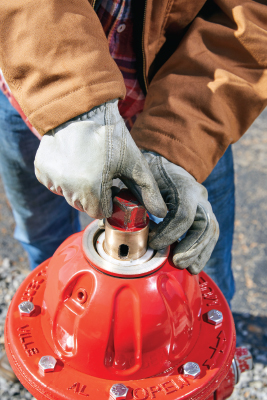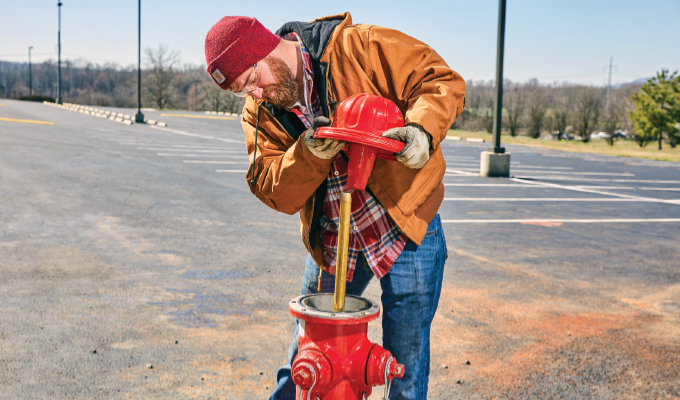By Patrick Nein and Alexander Bailey, Mueller Water Products
With any waterworks device that will be buried in the ground for long periods, regularly exceeding over fifty years, proper maintenance is essential to ensure they perform as needed and fulfill their expected life. But unlike many of these devices, a fire hydrant that does not work when required can have grave consequences.
The most effective way to keep a fire hydrant in working order is to have a biannual or annual testing and maintenance program. The frequency of the testing and maintenance will depend on the type of fire hydrants in the system (dry or wet barrel) and the climate in which they are installed. Fire hydrants in cold or harsh climates may need more frequent inspections and maintenance.
Here are some best practices for your maintenance program:
EXERCISING THE FIRE HYDRANT
This will ensure the fire hydrant operates as expected. It is important that when a fire hydrant is operated, the auxiliary valve tied to the hydrant is also exercised.
PROPER LUBRICATION OF THE FIRE HYDRANT
Fire hydrants are typically grease or oil-filled. Follow the manufacturer’s instructions on lubrication. Without proper lubrication, corrosion can occur making the hydrant difficult or, in some cases, impossible to operate.
FIRE HYDRANT FLUSHING
It is important to remove any foreign material that may be inside the fire hydrant or lead line. During flushing, we have seen many obscure things appear like soda cans, tire innertubes, bathroom rugs, and chunks of wood. These items can block the fire hydrant main valve hindering the ability to open or close the hydrant.
CHECKING FIRE HYDRANT FOR STANDING WATER
This is especially important in cold climates. The presence of a high-water table or clogged drains holes can cause water to accumulate in the fire hydrant. This accumulated water can freeze causing damage to the hydrant. This inspection can be done after flushing by holding your hand over the exposed nozzle to feel for small amounts of suction. This signals that the fire hydrant is draining properly. Some fire hydrants in areas with a higher water table may have plugged drains, these need to be pumped after use.
INSPECT TRAFFIC FEATURES
During the inspection, double-check that the breakaway devices are not damaged. Depending on the age and type of the fire hydrant, this feature could be breakaway flanges or breakaway bolts. Some fire hydrant models do not have a breakaway design. It is also important to inspect the fire hydrant surroundings. Make sure there are no obstructions hiding the fire hydrant, like bushes or debris, from firefighters. Homeowners sometimes landscape around the hydrants to hide it from their view or with the best intentions of beautifying, but with no maintenance, it can easily become difficult to find.
PROPER FIRE HYDRANT HEIGHT
A fire hydrant that has the incorrect height above the groundline can have serious implications if hit by a vehicle. A hydrant that is buried too low can cause a hydrant to not break as expected during a collision and make removal of the nozzle caps difficult. A hydrant that is buried to high may allow for a vehicle to impact the lower barrel. Improper fire hydrant height can cause not only more damage to the vehicle during a collision but also damage water piping systems.
INSPECT FIRE HYDRANT FOR LEAKS
The hydrant can be pressurized to inspect for leaks. This is achieved by removing a hydrant cap and operating the hydrant a few turns. Allow the hydrant barrel to fill until a small amount is coming out of the nozzle, this allows for as much air to escape as possible. Replace the cap and fully open the hydrant. With the hydrant pressurized, all visible joints can be inspected for leaks. A leaking hydrant can cause many issues including erosion of the soil in areas with poor drainage, accelerated corrosion, and groundwater contamination.

CHECK HYDRANT OUTLET NOZZLE CAPS
Over time, corrosion can make nozzle caps difficult to remove. Remove caps during each inspection and clean them. Adding food-grade lubrication or anti-seize to the nozzle and cap threads can assist with easier operation in the future.
RECORD KEEPING OF HYDRANT MAINTENANCE
This is very important for a municipality to know which hydrants have been repaired/inspected or need to be repaired/inspected. This is an important part of any maintenance and inspection program and benefits from more detail than less. It is also very important that any issue discovered during an inspection is repaired in a timely fashion. Any fire hydrant that is deemed inoperable should be black bagged or tagged to prevent accidental use and replaced or repaired as soon as possible.
SAFETY MEANS NO SHORTCUTS
Cities and municipalities also need to make sure that when buying new hydrants that they have the same threads and operating nut size as other hydrants in the area. Firefighters need to be able to quickly access fire hydrants and if their wrenches and hoses won’t fit, this can cause a dangerous delay. Hydrants with stainless steel components will last longer and are better protected against corrosive soil or hot soil. Proper thrust blocking and installation of a drain field will also help with the performance and longevity of the hydrant.
There are no shortcuts taken when it comes to manufacturing fire hydrants because they have a critical function and need to perform at a moment’s notice. Still, the most common cause of failure is the lack of a proactive preventative maintenance program. Municipal crews that have solid maintenance programs will have fewer repairs and more reliable performing hydrants.
Most manufacturers have a step-by-step document that walks operators through fire hydrant maintenance and inspection for their particular model. Also, the AWWA M17: Installation, Field Testing, and Maintenance of Fire Hydrants is an excellent resource that can be found on their website www.awwa.org. Generally speaking, the mechanics of fire hydrants have not changed that much, so once you have a good grasp of the basics you will be set for a long time.
FOR MORE INFORMATION
Patrick Nein is project manager and Alexander Bailey is application engineer for Mueller Water Products. Mueller Water Products is a leading manufacturer and marketer of products and services used in the transmission, distribution, and measurement of water in North America. The company’s broad product and service portfolio includes engineered valves, fire hydrants, metering products and systems, leak detection, and pipe condition assessment. It helps municipalities increase operational efficiencies, improve customer service, and prioritize capital spending, demonstrating why Mueller Water Products is “Where Intelligence Meets Infrastructure.” For more information, visit www.muellerwaterproducts.com.
MODERN PUMPING TODAY, February 2021
Did you enjoy this article?
Subscribe to the FREE Digital Edition of Modern Pumping Today Magazine!



